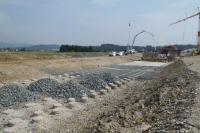Koralm, Graz - Klagenfurt Railway Line, Mittlern - Althofen Section, Contract Section 60.2 (Kühnsdorf)
Client: Austrian Railways Infrastructure AG
Development Period: 1996 to 2014
The Koralm Railway Line will soon connect the cities Graz and Klagenfurt with a new, 124 km long high performance railway line.
The objective contract section comprises a new track with a length of 2.8 km, two street overpasses, two railway bridges (lengths 225 m and 120 m) and the environmental tunnel Kühnsdorf with a length of 500 m. Furthermore, long-range road relocations and new road constructions, parts of the railway station Kühnsdorf-Klopeinersee as well as drainage measures were included in this project.
BGG Consult attended to this project section in the fields of geotechnics, hydrogeology and geology since the beginning of the planning phase. First of all, expert's reports were prepared for the route selection procedure. In the EIA phase, the basics were established and documents regarding the groundwater and geology presented. Subsequently, the reports for the permission according to railway law and for the construction tender were compiled, based on intense subsoil investigations. In addition, reports with regard to ground water lowering measures close to a spring reserve area had to be prepared for a permission procedure according to laws pertaining to water and waterways.
Finally, the construction work was supervised with regard to geology, geotechnics and hydrogeology.
Environmental Tunnel Kühnsdorf:
At the base of the Environmental Tunnel Kühnsdorf, the underground consists mostly of stillwater sediments with an extremely low bearing capacity. Well bearing materials (moraine or quaternary gravel) set in between 10 m and 15 m below top grade surface. The ground water table is situated near to the surface. For this reason, a deep foundation was planned from the beginning. During construction, it was decided, based on a value engineering proposal, to implement rigid cast-in-place piles without reinforcement instead of the originally proposed micropiles.
For the groundwater exchange, a filter layer was placed directly below the bottom plate.
Due to the consistent geotechnical attendance, a technically adequate and economic foundation could be granted, despite the existing difficult underground condition.
October 2016
